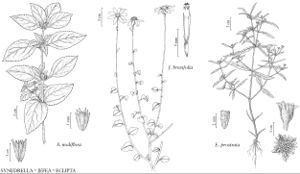Synedrella
Fruct. Sem. Pl. 2: 456, plate 171, fig. 7. 1791.
| Taxon | Illustrator ⠉ | |
|---|---|---|
 | Synedrella nodiflora Jefea brevifolia Eclipta prostrata | Bee F. Gunn Yevonn Wilson-Ramsey Marjorie C. Leggitt |
Annuals, 10–80+ cm. Stems erect or ascending, branched from bases or ± throughout. Leaves cauline; opposite; petiolate; blades (usually 3-nerved) ovate to elliptic, bases cuneate to rounded, margins toothed, faces ± scabrous. Heads radiate, (sessile or subsessile) in axillary glomerules or borne singly. Involucres cylindric to campanulate, 3–6 mm diam. Phyllaries persistent, 2–5+ in 1 (–2) series (lanceolate, herbaceous to chartaceous). Receptacles convex, paleate (paleae lance-linear, scarious, flat or weakly cupped at bases). Ray-florets 2–9+ (in 1–2 series), pistillate, fertile; corollas yellowish. Disc-florets 4–12+, bisexual, fertile; corollas yellowish, tubes about equaling slightly ampliate, cylindric throats, lobes 4, rounded-deltate. Cypselae dimorphic, strongly obcompressed or flattened, narrowly oval and winged (ray, wings laciniate) or linear-cuneate and not winged (disc); pappi persistent, of 2 triangular scales (ray) or 2–3 subulate scales or awns (disc). x = 20?
Distribution
Introduced; Mexico, West Indies, Central America, South America, also in Asia, Africa, Pacific Islands, Australia
Discussion
Species 1.
Selected References
None.
Lower Taxa
"broader" is not a number.